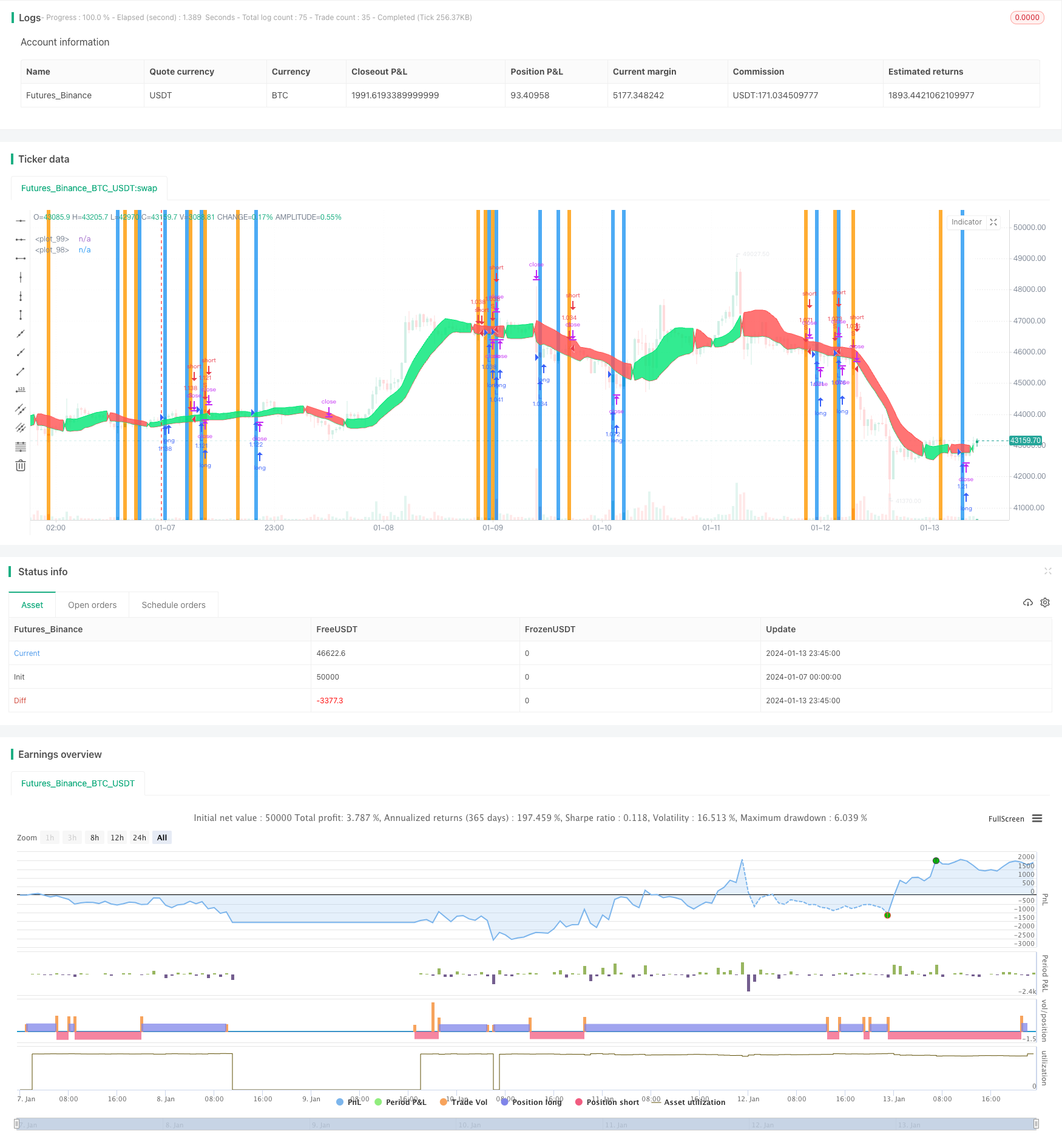
Overview
This strategy combines the Spiral Channel indicator and the Rate of Change (ROC) indicator. It generates buy signals when the price breaks through the upper band and moving average, and sell signals when the price breaks through the lower band and moving average. The Spiral Channel determines the trend direction while the ROC detects price momentum. By requiring agreement between both indicators, the strategy aims at improving the reliability of trading signals and win rate.
Strategy Logic
The strategy is based on two key indicators:
Spiral Channels: Plot upper and lower bands to determine trend direction. Price breaking above upper band indicates upward trend, while breaking below lower band signals downward trend.
Rate of Change (ROC): Detect price acceleration. ROC above a positive threshold suggests accelerating upward price move, while ROC below a negative threshold points to accelerating downward move.
Buy signals are generated when both Spiral Channel and ROC give bullish indications, namely price breaking above upper band coupled with accelerating upward momentum. Sell signals are triggered when both indicators turn bearish.
The combined signals help avoid trading against the trend and improve reliability.
Advantages
Reliable signals with higher win rate by requiring agreement between trend and momentum.
Customizable trading frequency through parameter tuning, e.g. adjust ROC parameters.
Stop loss to limit downside risk on individual trades.
Re-enter mechanism to ride trends and further boost profitability.
Risks
Missing some trading opportunities and limiting profit potential due to signal reliability requirement.
Vulnerable to being trapped when trend reverses, potentially leading to large losses.
Poor parameter tuning can result in too few or too many signals.
Fixed stop loss percentage unable to prevent severe losses on huge adverse price swings.
Enhancement Opportunities
Optimize ROC parameters for best performance.
Test different stop loss levels to balance risk and reward.
Add other filters like volume, volatility indicators to refine signals.
Evaluate performance across different markets to find best fit.
Introduce dynamic position sizing for varying market conditions.
Conclusion
The strategy combines Spiral Channel and ROC to assess trend direction and momentum. It aims at signal reliability while maintaining profitability through re-entry and parameter tuning. Risk is mainly controlled by fixed percentage stop loss. Overall it is a relatively complete framework worthy as a baseline quantitative trading strategy.
/*backtest
start: 2024-01-07 00:00:00
end: 2024-01-14 00:00:00
period: 45m
basePeriod: 5m
exchanges: [{"eid":"Futures_Binance","currency":"BTC_USDT"}]
*/
//@version=4
strategy("SSL Chaikin BF 🚀", overlay=true, precision=2, initial_capital=10000, default_qty_type=strategy.percent_of_equity, default_qty_value=100, commission_type=strategy.commission.percent, commission_value=0.075)
/////////////// Time Frame ///////////////
_0 = input(false, "════════ Test Period ═══════")
testStartYear = input(2017, "Backtest Start Year")
testStartMonth = input(1, "Backtest Start Month")
testStartDay = input(1, "Backtest Start Day")
testPeriodStart = timestamp(testStartYear,testStartMonth,testStartDay, 0, 0)
testStopYear = input(2019, "Backtest Stop Year")
testStopMonth = input(12, "Backtest Stop Month")
testStopDay = input(31, "Backtest Stop Day")
testPeriodStop = timestamp(testStopYear,testStopMonth,testStopDay, 0, 0)
testPeriod() => true
/////////////// Chaikin MF ///////////////
_1 = input(false, "═══════ Chaikin MF ═══════")
length = input(20, minval=1, title = "Chaikin SMA Length")
upperThreshold = input(0.04, step=0.01, title="Upper Threshold")
lowerThreshold = input(0.02, step=0.01, title="Lower Threshold")
ad = close==high and close==low or high==low ? 0 : ((2*close-low-high)/(high-low))*volume
mf = sum(ad, length) / sum(volume, length)
/////////////// SSL Channels ///////////////
_2 = input(false, "═════════ SSL ══════════")
len1=input(title="SMA Length 1", defval=12)
len2=input(title="SMA Length 2", defval=13)
smaHigh = sma(high, len1)
smaLow = sma(low, len2)
Hlv = 0
Hlv := close > smaHigh ? 1 : close < smaLow ? -1 : Hlv[1]
sslDown = Hlv < 0 ? smaHigh : smaLow
sslUp = Hlv < 0 ? smaLow : smaHigh
///////////// Rate Of Change /////////////
_3 = input(false, "══════ Rate of Change ══════")
source = close
roclength = input(13, "ROC Length", minval=1)
pcntChange = input(4, "ROC % Change", minval=1)
roc = 100 * (source - source[roclength]) / source[roclength]
emaroc = ema(roc, roclength / 2)
isMoving() => emaroc > (pcntChange / 2) or emaroc < (0 - (pcntChange / 2))
/////////////// Strategy ///////////////
long = sslUp > sslDown and isMoving() or crossover(mf, upperThreshold)
short = sslUp < sslDown and isMoving() or crossunder(mf, lowerThreshold)
last_long = 0.0
last_short = 0.0
last_long := long ? time : nz(last_long[1])
last_short := short ? time : nz(last_short[1])
long_signal = crossover(last_long, last_short)
short_signal = crossover(last_short, last_long)
last_open_long_signal = 0.0
last_open_short_signal = 0.0
last_open_long_signal := long_signal ? open : nz(last_open_long_signal[1])
last_open_short_signal := short_signal ? open : nz(last_open_short_signal[1])
last_long_signal = 0.0
last_short_signal = 0.0
last_long_signal := long_signal ? time : nz(last_long_signal[1])
last_short_signal := short_signal ? time : nz(last_short_signal[1])
in_long_signal = last_long_signal > last_short_signal
in_short_signal = last_short_signal > last_long_signal
last_high = 0.0
last_low = 0.0
last_high := not in_long_signal ? na : in_long_signal and (na(last_high[1]) or high > nz(last_high[1])) ? high : nz(last_high[1])
last_low := not in_short_signal ? na : in_short_signal and (na(last_low[1]) or low < nz(last_low[1])) ? low : nz(last_low[1])
since_longEntry = barssince(last_open_long_signal != last_open_long_signal[1])
since_shortEntry = barssince(last_open_short_signal != last_open_short_signal[1])
//////////////// Stop loss ///////////////
_4 = input(false, "════════ Stop Loss ═══════")
sl_inp = input(2.0, title='Stop Loss %') / 100
slLong = in_long_signal ? strategy.position_avg_price * (1 - sl_inp) : na
slShort = strategy.position_avg_price * (1 + sl_inp)
long_sl = in_long_signal ? slLong : na
short_sl = in_short_signal ? slShort : na
/////////////// Execution ///////////////
if testPeriod()
strategy.entry("L", strategy.long, when=long)
strategy.entry("S", strategy.short, when=short)
strategy.exit("L SL", "L", stop=long_sl, when=since_longEntry > 0)
strategy.exit("S SL", "S", stop=short_sl, when=since_shortEntry > 0)
/////////////// Plotting ///////////////
p1 = plot(sslDown, linewidth = 1, color=color.red)
p2 = plot(sslUp, linewidth = 1, color=color.lime)
fill(p1, p2, color = sslDown < sslUp ? color.lime : color.red, transp=80)
bgcolor(isMoving() ? long ? color.green : short ? color.red : na : color.white, transp=80)
bgcolor(long_signal ? color.lime : short_signal ? color.red : na, transp=30)
bgcolor(crossover(mf, upperThreshold) ? color.blue : crossunder(mf, lowerThreshold) ? color.orange : na, transp=30)